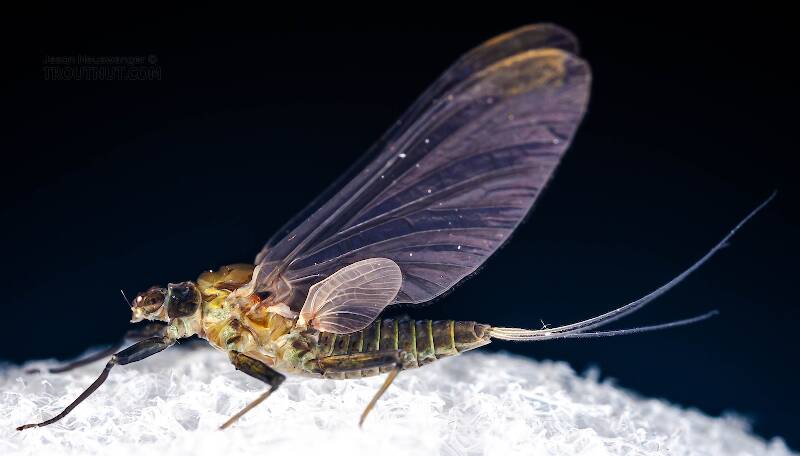
Blue-winged Olives
Baetis
Tiny Baetis mayflies are perhaps the most commonly encountered and imitated by anglers on all American trout streams due to their great abundance, widespread distribution, and trout-friendly emergence habits.


Mayfly Species Drunella tuberculata
Species Range
Identification
To determine whether a specimen of Drunella belongs to Drunella tuberculata, use the Key to Species of Drunella Nymphs.
Physical description
Most physical descriptions on Troutnut are direct or slightly edited quotes from the original scientific sources describing or updating the species, although there may be errors in copying them to this website. Such descriptions aren't always definitive, because species often turn out to be more variable than the original describers observed. In some cases, only a single specimen was described! However, they are useful starting points.
Male Spinner
Wing length: 9 mm
A species of the fuscata group (now a synonym of Drunella walkeri); by the nymphal structures, closely allied to E. conestee (now a synonym of Drunella tuberculata), and E. allegheniensis (now a synonym of Drunella allegheniensis). Imago very similar to E. fuscata, but distinguished from it by the dark ventral abdominal markings and the greater number of black spots on the femora. The lateral extension of the 9th segment of the nymph is not flaring, as in E. allegheniensis: the thoracic tubercles distinguish it from E. conestee (now a synonym of Drunella tuberculata).
Head and thorax dark reddish to blackish brown; pale areas anterior to and laterad of the scutellum, and along the antero-lateral margin of the mesonotum. Pleura with paler shading. All coxae and trochanters yellowish, the former sometimes with one or more dark dots. Fore femur and tibia blackish; tarsus pale to smoky brown. Middle and hind femora yellowish, shaded with olive brown; tibiae and tarsi pale yellowish. All femora heavily sprinkled with black dots. Wings hyaline; longitudinal veins smoky to pale reddish brown. Tergites 1 and 7-10 largely dark reddish to blackish brown; 7 and 8 may have a pale median streak between the dark lateral areas. Middle tergites somewhat paler, the middle areas yellowish brown, the posterior margins and lateral areas dark brown; traces of a broken dark mid-dorsal line. Pleural fold pale. Sternites 1-8 light yellowish brown, the anterior ones sometimes tinged with reddish and washed with blackish. Sternite 9 is deep blackish brown. Each pale sternite has a blackish lateral streak near the pleural fold, and a curved row of four dark dots between these, across the middle of the segment. Forceps smoky brown, penes blackish (see fig. 153). Tails smoky brown.
Described as E. conestee
Body length 6 mm, wing length 7 mm
A species of the fuscata group (now a synonym of Drunella walkeri); by the nymphal structures allied to E. tuberculata (now a synonym of Drunella tuberculata).
Abdomen of male imago tinged with orange or rose color; body and legs with purplish rose markings; tails brown.
Eyes yellowish to orange. Head light brown tinged with purple. Pronotum largely purplish rose; a prominent median carina. Mesonotum light olive brown; metanotum dark brown; both with purplish tinges. Pleura light olive brown, the sutures pale. Two rose colored streaks anterior to the wing roots. Fore femur greyish, streaked with purplish rose; tibia and tarsus dark olive brown. Middle and hind legs light olive brown, joinings and claws dark brown. Wings hyaline, veins pale yellowish; a purplish brown stain at base of fore wing. Abdominal tergites 1-3 deep purple with rose tinges; 4 and 5 orange marked with deep purplish red; 6-9 similar to 4 and 5 but paler. Anterior and middle tergites are darker on each side of mid-dorsal line, halfway to the pleural fold, and at the center of the pleural fold. Sternites greyish lavender with rose tinges; 7-9 yellowish. Tails orange brown at base, shading into smoky brown; joinings slightly darker. Forceps smoky brown; penes deep rose.
Nymph
The nymph has very short frontal horns, and a frontal shelf which is slightly notched to receive the bases of the antennae (see fig. 151 h). Occipital tubercles present; tubercles also on the pronota and mesonota. Femora flattened, the fore femur widest and bearing teeth or spines on the anterior margin. Tibial ‘thumb’ about half as long as the tarsus, rather stout, almost straight (see fig. 62 ). Dorsal spines present on abdominal tergites. Gills borne on segments 3-7. Posterior margins of tergites 8 and 9 are fringed with long hairs. General color (in life) dull brownish green, often with a prominent whitish dorsal stripe. Paler ventrally, with a row of indistinct dark marks on each side of the abdominal sternites, somewhat as in E. serrata (now a synonym of Serratella serrata). Tails yellow at base, with one brown band; beyond the middle, alternately yellow and brown.
Described as E. conestee
The frontal horns of the nymphs are very short; the frontal shelf is slightly notched laterally (see fig. 158b). A pair of short blunt tubercles on the occiput. No thoracic tubercles, but the dorsal surface is irregular. Many spines on the anterior margin of the fore femur, and a few on the posterior; tibial ‘thumb’ short, blunt. Dorsal spines present on tergites 2-7. Gills borne on segments 3-7. Head brown mottled with yellow and darker brown; thorax yellow with irregular brown mottling and streaks. Legs yellowish with indistinct brown bands. Tergites 1-4 brown mottled with yellowish Iaterally; 5 and 6 yellow; 7 and 8 yellow mottled with brown; 9 and 10 dark brown. Yellowish to yellowish brown ventrally; sternite 9 dark brown. Tails yellow to yellowish brown; 4 to 7 narrow whitish bands.
Specimens of the Mayfly Species Drunella tuberculata
1 Female Dun

It certainly has a different look and much more robust body shape from Drunella lata duns I photographed a couple weeks earlier, so I doubt it's that species. Using distribution records to eliminate other choices narrows this down to Drunella tuberculata or Drunella walkeri.
Markings described for the abdominal sternites of the male spinner of Drunella tuberculata are suspiciously similar to those on this female dun. Also, this dun is 9.5mm long (my ruler pic isn't very good, but I'm basing this on measuring the real thing). The size range given in the old Allen & Edmunds keys for walkeri females is 7-8mm, while tuberculata is 9-11mm. For these reasons I'm sticking it in tuberculata for now.
This is the only Drunella mayfly I saw all day. I scooped it off the water as it emerged at around 7pm from a big Catskill tailwater.
Discussions of Drunella tuberculata
Start a Discussion of Drunella tuberculata
References
- Needham, James G., Jay R. Traver, and Yin-Chi Hsu. 1935. The Biology of Mayflies. Comstock Publishing Company, Inc.
Mayfly Species Drunella tuberculata
Species Range
Resources
- NatureServe
- Integrated Taxonomic Information System
- Global Biodiversity Information Facility
- Described by Morgan (1911)

